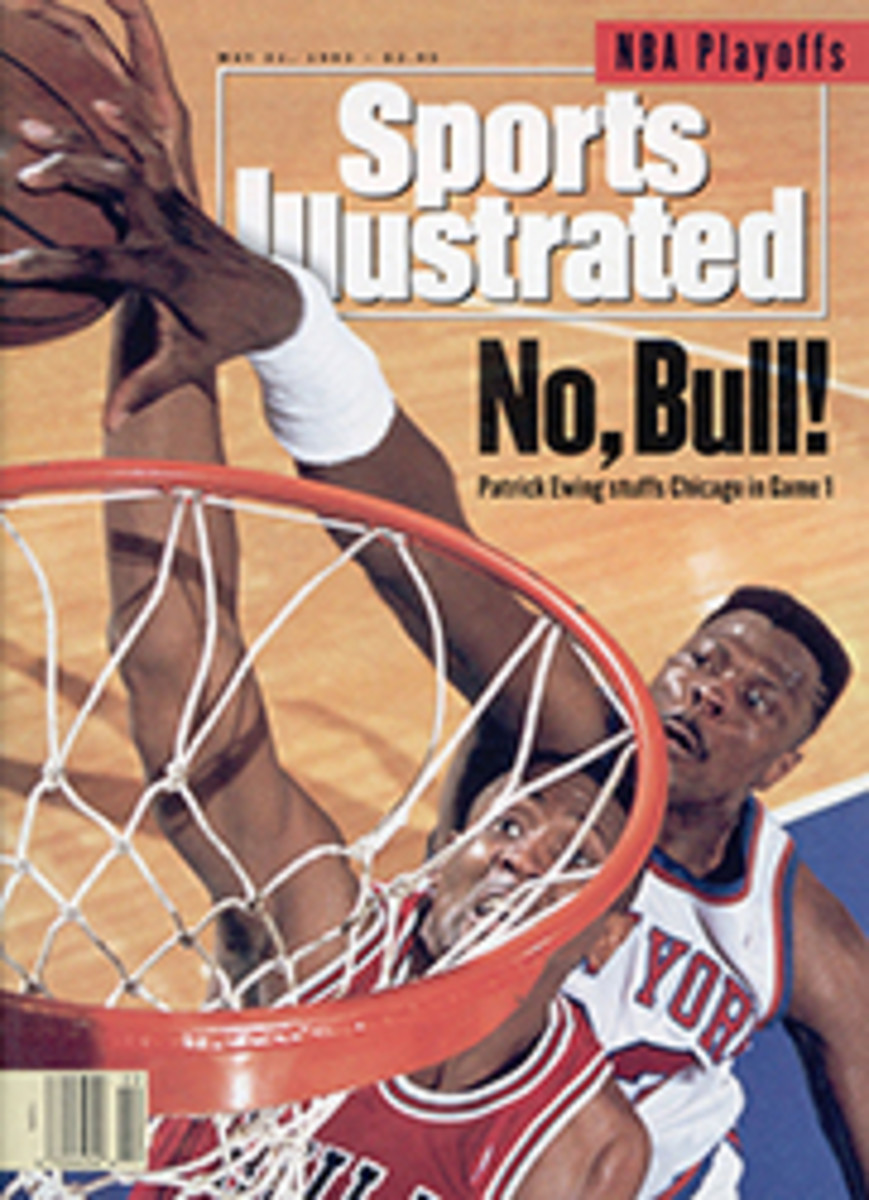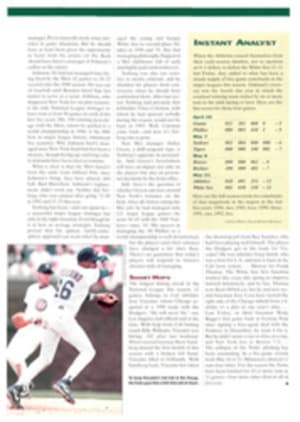
A Salute to Sweet Swinger
When he was sharp and young and his swing was as fluid as any in golf, Teddy Rhodes competed against Ben Hogan, Sam Snead and Byron Nelson. In the late 1940s there were a number of gifted pro golfers who were black, but Rhodes was considered the best. "Teddy was a fantastic golfer," says Lee Elder, who in 1975 became the first black to play in the Masters. "His game was a carbon copy of Calvin Peete's, so straight that you could draw an arrow [with it]. His iron game was probably the best that I'll ever see. He hit two-and three-irons at the pin."
Ask Charlie Sifford, who in 1967 became the first black to win a PGA tournament, whether he thinks Rhodes was the best black to ever play the game. "Ain't no think in it," Sifford says. "I know he was. It took me six years to beat him. Nobody could play as consistently as Teddy."
Rhodes was born in Nashville in 1916 and learned to play golf while caddying at local country clubs for, among others, Lloyd Mangrum, winner of the 1946 U.S. Open. Tall and slender, Rhodes had such a graceful swing that heavyweight champion Joe Louis dubbed him Sweet Swinger after meeting him in 1945. An avid golfer, Louis hired Rhodes to travel with him as his personal instructor and playing partner, a relationship that would last long after Louis left the ring.
In the late '40s and early '50s, Rhodes dominated the mostly black United Golf Association (UGA) tour, winning the Joe Louis Invitational in Detroit four consecutive times and the National Negro Open title three years in a row. Back then the PGA had a Caucasians-only clause in its constitution, a rule that said only whites could be members of the association and play on the Tour.
The black pros knew all about the Caucasians-only clause; it was the reason they played for a $500 first prize on a public course in Atlanta or Pittsburgh, while white pros were competing for a $2,500 first prize at a country club nearby. Three major tournaments, though, were unique: the Los Angeles Open, the Canadian Open and the Tam O'Shanter World Championship of Golf in Chicago allowed any qualified player to enter. These events gave Rhodes the opportunity to prove he was talented enough to compete with the likes of Snead and Hogan, as well as with the rest of the PGA. After the first round of the 1947 L.A. Open, the Los Angeles Times reported, "There were five tied at 71, including...Teddy Rhodes (the latter being America's greatest Negro golfer)." At the Tarn O'Shanter, Rhodes finished in 14th place in 1948 and '49. And during that time he twice traveled to Toronto for the Canadian Open.
By 1948 Rhodes was driving from tournament to tournament on the UGA circuit in a big Buick that Louis had bought for him. His golf game was solid, and the time had come, he thought, to force the PGA to let him into its tournaments. He saw his opening after the 1948 Los Angeles Open, in which he finished 20th. Tour rules stipulated that the top 60 finishers in a PGA event automatically qualified for the following tournament. But when Rhodes and two other blacks, Bill Spiller and Madison Gunter, tried to play in the Richmond (Calif.) Open, the PGA blocked their entry. The three promptly filed a $315,000 lawsuit in Los Angeles against the tournament and the PGA, claiming that they had been denied the right to pursue their profession.
In September 1948, just before the suit went to court, the PGA pledged that it would no longer prevent blacks from playing in its tournaments, though they still couldn't be members of the PGA. As a result the three players dropped the suit without getting a dime in settlement money. And then the PGA quickly changed its tournament policy: An "open" became an "invitational" event in which players had to be approved by the individual tournament and its sponsors. So Rhodes went back to hitting balls on municipal courses.
Even Louis found he could not outslug the PGA. On Jan. 14, 1952, a few days before the San Diego Open, the champ started a war of words in the media with the PGA's president, Horton Smith. Walter Winchell reported on his radio program that Louis had called Smith "another Hitler" for keeping blacks from participating because of the Caucasians-only clause. By the end of the week the PGA announced that it would "case its tournament ban" on black players. Blacks still couldn't become members of the PGA, but if, after being invited, they could qualify for a handful of open spots at tournaments, or if by some miracle they received sponsor invitations, the PGA wouldn't keep them from playing in its events.
The following Monday morning, seven black players stood at the 1st tee of the Phoenix Country Club, attempting to qualify for the Phoenix Open. Rhodes, Sifford, Louis and Eural Clark teed off first. Two of them put their approach shots within birdie range on the 1st green. But when Sifford walked up to the pin, he saw something he had never seen on any golf course. The cup was full of excrement. Someone knew who would be the first players to reach the green that morning.
The ploy almost worked. Sifford's nerves were so jangled that he shot a poor round, as did three of the other black players. But Rhodes qualified, as did Spiller and Clark. And when the first round was over, Rhodes was among the leaders with an even-par 71. "I haven't been playing too much lately to score too well," he wryly told the newspapers.
Rhodes refused to make a scene about the incident at the 1st hole. "Teddy told me that to get angry was the equivalent of losing your game," says Maggie Hathaway, a former golf writer and editor for the black-owned weekly Los Angeles Sentinel, who knew Rhodes well. "Getting angry made him so nervous that sometimes he drew his putter back and couldn't bring it forward."
During the rest of the '50s Rhodes played wherever and whenever he could. He won the National Negro Open title again in 1957, and he played in the first black foursome on the Western Avenue Golf Course in Los Angeles, looking on as Spiller beat Louis out of $7,000. In 1949 Rhodes married Claudia Oliver, a dancer who performed at the top black nightclubs in the country. A year later the couple had a daughter, Deborah, who is an actress living in Los Angeles.
Rhodes believed it was his duty to do as much as he could for talented young blacks who had the spirit to fight for equality on the pro circuit. Elder, who grew up in Dallas, got his first taste of tour life while traveling with Rhodes on the UGA tour from the late 1940s to the mid-'50s and caddying for him when Rhodes qualified for PGA tournaments in Detroit and St. Paul. "I saw Teddy give away so much money," says Elder. "When he went in to get golf shoes for himself, he'd say, 'Give my little friend here a pair.' 'Give my little friend an alpaca sweater.' I spent many hours under that big tree at Forest Park [a St. Louis course] hitting balls while Teddy was out there trying to make enough money for us to live on."
In Sifford, Rhodes found his opposite, a tough, mean fighter with a game solid enough to compete with those on the PGA Tour. It was Rhodes who suggested Sifford for a job as the personal pro of Billy Eckstine, the jazz singer. Rhodes and Sifford became friends and traveled together until the early 1960s, when Rhodes's health began to deteriorate.
By the time the PGA finally dropped the Caucasians-only clause, in November 1961, Rhodes was suffering from a kidney ailment that kept him bedridden for long stretches of time. He died of a heart attack in a Nashville motel on July 4, 1969.
The Western Avenue Golf Course in South Central Los Angeles, where Rhodes and Sifford were once the top players, is now called the Chester L. Washington Golf Course, named after the former publisher of the Sentinel. Located only a few blocks from the scene of last year's riots, the course is frequented by blacks, Koreans, Japanese and a few whites. In the snack bar, where gray-haired black men play dominoes, you might walk right past the photo that hangs above the jukebox. It's a picture of a handsome man finishing a golf swing with a high follow-through. There is no plaque to identify the player. Only by asking will you discover that the photo is of Teddy Rhodes.
TWO ILLUSTRATIONS
MARK ENGLISH
Jim Gullo is the co-author, with Charlie Sifford, of Sifford's autobiography, "Just Let Me Play."

